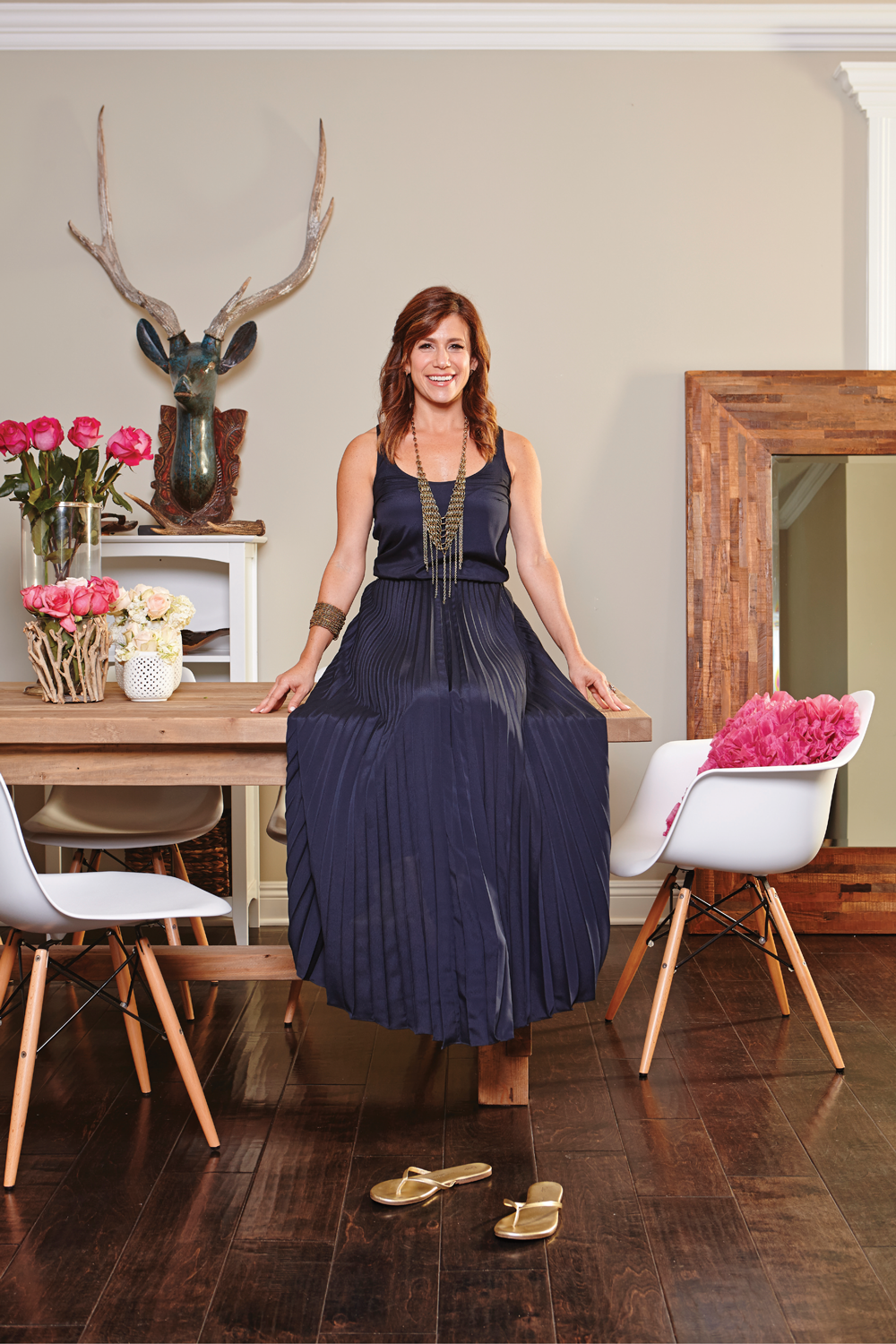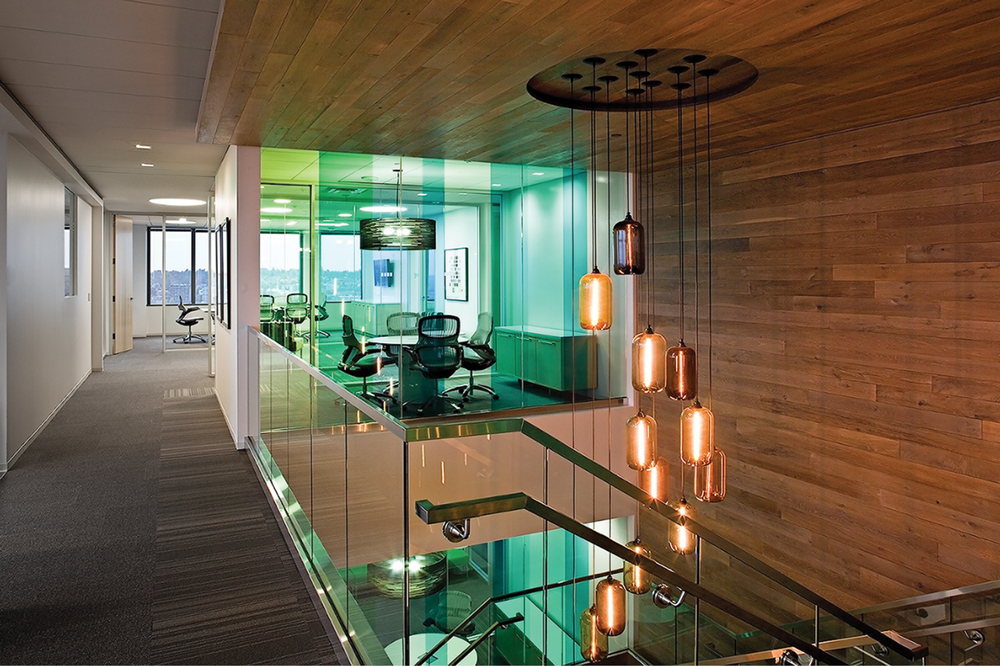
Inside Job
By Audrey Michelle Mast (BA ’00)
Architectural history is, by and large, concerned with how great buildings look: their sites, shapes and façades. But most buildings aren’t monuments; they’re shelters. Their inhabitants experience them from the inside. Interior architecture, as a discipline, is concerned with how spaces feel. Interior architects might reimagine the space within a century-old skyscraper or work with exterior-focused architects to create a new building from the ground up. These three Columbia College Chicago grads specialize in designing within walls—whether or not they exist yet.
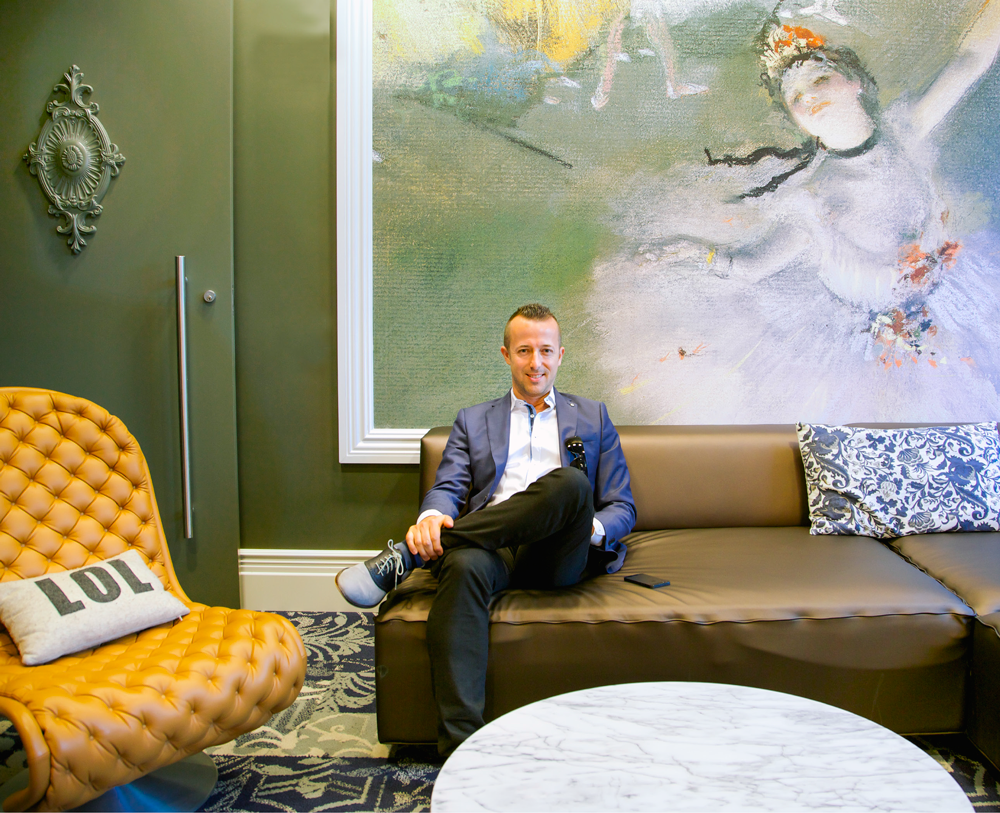
TOP: This space for environmental law firm Manko, Gold, Katcher & Fox, LLP, near Philadelphia, includes expansive glass partitions that allow maximum daylight into the room. The conference space, which incorporates recycled materials, also doubles as an area for industry galas and evening functions. ABOVE: Michael Bonomo relaxes in a green room he designed at The Huffington Post and AOL.
MICHAEL BONOMO
Growing up in Crystal Lake, just outside Chicago, Michael Bonomo (BA ’99) would trace over the architectural plans his father brought home from his building industry job. “I’ve been drawing and designing since I was about 7 years old,” he says. “I knew from a very young age that I wanted to work with the spaces people occupy and have an impact on how people use them.”
Today, Bonomo is the director of interior design and a principal for Francis Cauffman, a global design firm with offices in New York and Philadelphia. As an award-winning interior architect with an extensive portfolio of retail, commercial and institutional projects, he shapes the work environments of trendsetting clients such as Bloomberg, Spotify, the Huffington Post and the New School.
“My particular affinity is for fast-paced clients with edgy design interests.”
By nature, the global design field is both collaborative and competitive. When Bonomo reflects on his time at Columbia, he remembers diversity, small classes, interactive studios—and lots of healthy competition. “We all wanted to have the best solutions. We were all pushing each other to be the best we could be,” he says. “But what drew me most to Columbia was that Chicago, as a city, is a campus. All the midcentury modern masters … provide this amazing mosaic of experiences and sites to learn from.”
One of Bonomo’s favorite professors was Bernard Wideroe, an acclaimed sculptor, who passed away in 2012 after a 20-year career as an artist and educator. “He was very tough, but I had a good connection with him, and we always had the most interesting conversations about design,” Bonomo says. “He really had a no-bullshit approach to life. … I think I share the same sentiment.”
By the time Bonomo graduated in 1999, he had completed two internships at local firms and secured a full-time position at Horn Design Architecture. In 2000, he moved to New York to work with Berger Rait Design Associates, a job he describes as “very exciting and challenging for the speed of business.”
“There was an extremely aggressive schedule for my first New York client … but at the time there were no budgets,” Bonomo says. “It was about how much you could design, how quickly, how cutting-edge.”
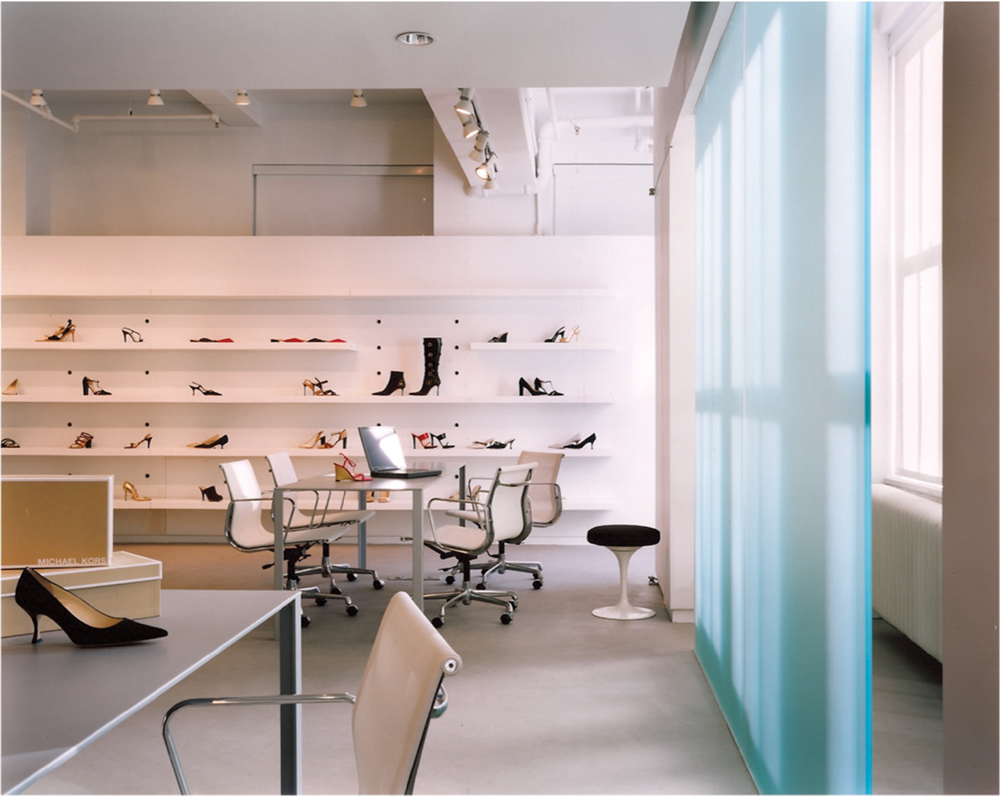
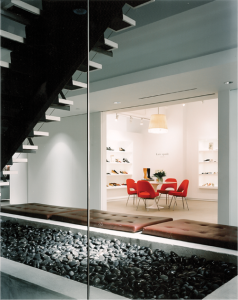
This joint Kate Spade and Michael Kors
showroom in New York City offers a suite of spaces for visiting buyers to select and
negotiate which products will be carried
under their retail brands. The white back-
drop of the display “allows fine detailing
of products to be expressed,” says Bonomo. Full-height wall panels slide, providing flexibility as needed in this two-story jewel-box interior.
But after 9/11, the economy of Manhattan changed overnight. In the midst of uncertainty, Bonomo launched his own practice. “It taught me a lot about business development … working very efficiently and very nimbly,” he says. He worked solo for about a year before he was recruited by TPG Architecture, then by Mancini Duffy, where he worked until he joined Francis Cauffman in 2011.
“My particular affinity is for fast-paced clients with edgy design interests,” says Bonomo. But regardless of the project or sector, he will often “push clients outside their comfort zone.” He is the co-author of a 2012 book, Phonebooths & Mailboxes: the Way We Work Now, which explores the future of workplace design in a “tech-forward mobile world.” When working with clients to reimagine their offices, he asks: “How do we make it innovative? Attract and retain great talent? Create curb appeal for clients who are visiting?”
The answers are fresh, creative solutions such as adjustable standing/ sitting workbenches; “smart bars” for efficient, flexible onsite tech support; and stylish, inviting lounge areas that foster interaction. “They’ve hired us to help them reach their ultimate potential,” he says of his clients. “We can enhance their business and their return on investment.”
In Manhattan, such investments have high stakes. Real estate costs are high and square footage is at a premium. But Bonomo sees each project as an opportunity for innovation: “Shrinking real estate doesn’t mean the space has to be boring.”
STACEY COHEN
When it comes to starting a business, “You can make a million plans, but you don’t know how you’re necessarily going to get there,” says Los Angeles-based interior design entrepreneur Stacey Cohen (BA ’96). “It was a long journey. There were a lot of different twists and turns.”
The Detroit-area native began her undergraduate studies at Ohio State University as a journalism major with a strong creative streak. Although she loved traditional college life at a Big Ten school, she was drawn to city life. She transferred to Columbia, which offered an “out-of-the-box approach,” a faculty of working professionals and a bustling urban campus.
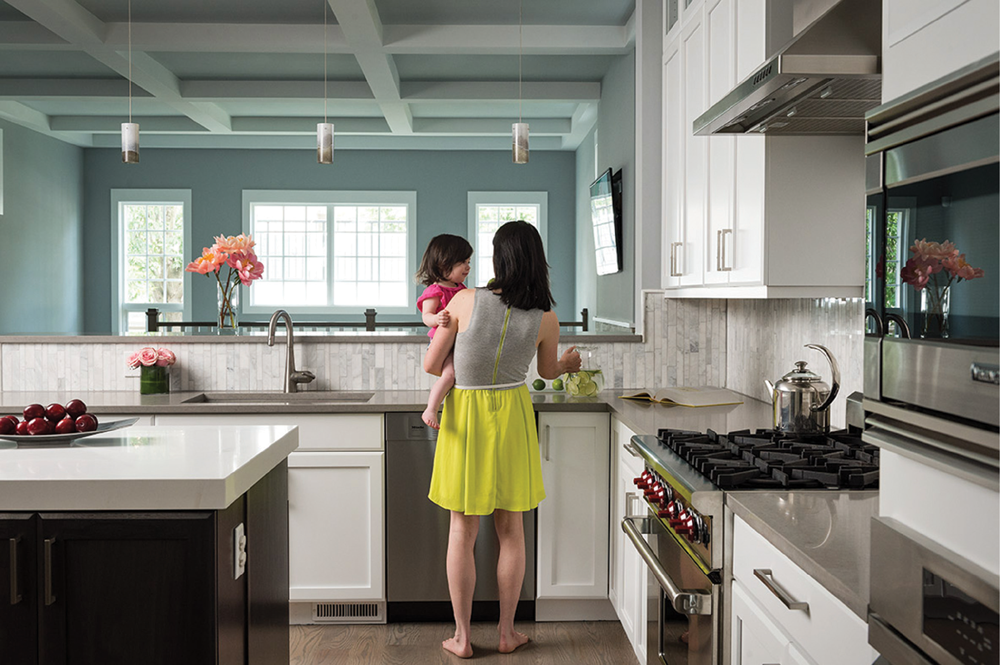
Cohen’s vibrant designs brighten this family kitchen in Chicago’s Irving Park neighborhood. “I still admire this project
as one of the most completely thought-out spaces fit for a young family,” she says.
Cohen say a series of serendipities shaped her career. She was a correspondent for the Columbia Chronicle on MTV’s Rock the Vote campaign during the 1996 presidential election. Years later, that experience and a connection with a fellow Columbia alumna led to a set design internship at MTV Studios in New York, a job that acted as a springboard for her career into interiors.
“It takes time, perseverance and discipline …thinking out what you want, what can get you there.”
After earning an associate’s degree in interior architecture from Parsons School of Design in New York, Cohen studied for a master’s of architecture at the University of Illinois at Chicago, immersing herself in green design strategies and earning LEED (Leadership in Energy & Environmental Design) certification. In the midst of the 2009 recession, she chose to leave school and focus on her own firm, Stacey Cohen Interiors. “It was not the most profitable time, but the lessons learned were priceless,” she says.

Cohen describes the interior design for this Chicago condo as “Morocco meets Manhattan.” Her client, a flight attendant in the 1960s, wanted a space inspired by her world travels and bohemian style.
Cohen’s recent endeavors include an e-book, Online Office, billed as “a business companion for creative entrepreneurs.” The book is a guide for aspiring creatives in navigating clients and vendors, marketing and managing a team—Cohen’s own hard-won lessons, interpreted for the digital age. But the message is timeless: “It takes time and perseverance and discipline … thinking out what you want and what can get you there.”
MICHELE MCMINN
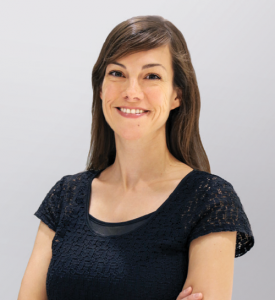
Working at Chicago firm Perkins & Will,
McMinn brings color and simplicity to the offices of this Seattle client.
“I can’t think of a better place, honestly, to go to architecture school than Chicago,” says Michele McMinn (MFA ’06).
McMinn studied fine arts and behavioral neuroscience at Tulane University before pursuing interior architecture at Columbia. She says she wanted to be an architect as a child, but didn’t reconnect with that desire until after she graduated from college. She was working in visual merchandising, unsure of her career path, when her greataunt reminded her of her childhood dream. “She said, ‘Michele, you always told everyone you were going to be an architect. What happened to that?’… It was like a light bulb went off.”
McMinn researched the field and a plan began to take shape. “It really aligns with how my brain works,” she says. “I’m not really hard right or left brained. … It’s only natural that [my career] progressed to something that bridges art and science.”
As a senior interior designer at Nashville’s Gresham, Smith and Partners, McMinn specializes in environmentally sensitive and resource-efficient spaces. She incorporates sustainable technology like LED light fixtures that automatically dim according to the amount of natural light in a room. Her designs use regional woods and other materials sourced locally, recycled content in furnishings, and low-flow water fixtures.
When McMinn studied at Columbia, green design was just becoming a buzzword. She gained hands-on experience alongside professors immersed in the design world. “The fact that my professors worked in the field was critical for me,” she says. “And because the professors were practitioners, it led to a deep network.”
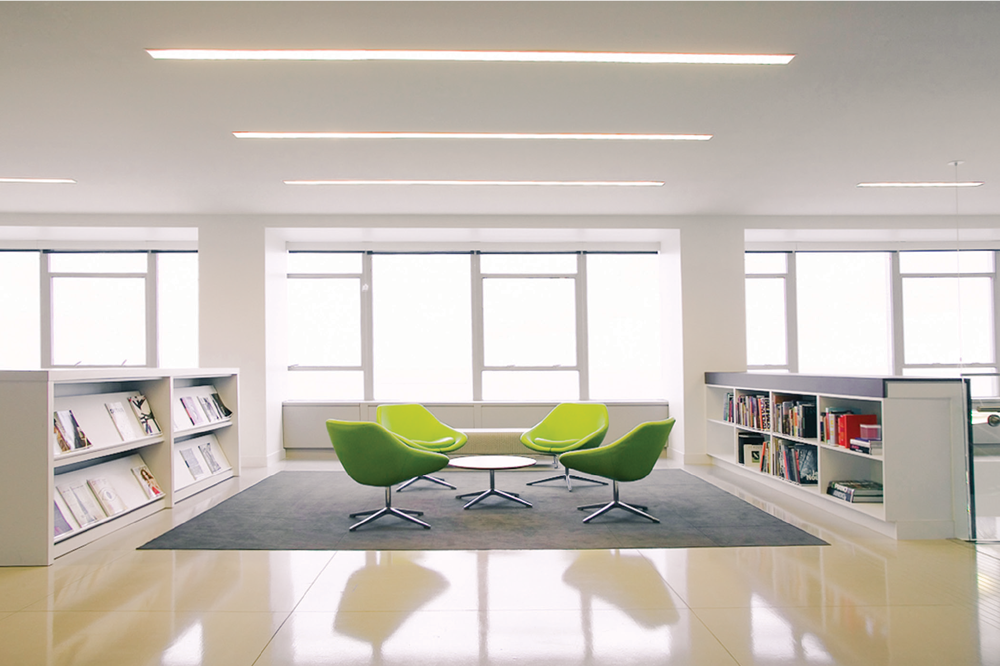
The LEED Silver-certified, luminous designs at architecture firm RTKL Chicago. Some spaces at the firm incorporate lights that dim according to the natural light in the room.
That network helped McMinn join the Chicago office of architecture firm RTKL as a student intern and secure a full-time job before graduation. It was a small but growing international firm; McMinn was the 30th employee hired. (By the time she left, the firm had grown to 100 employees.)
“It’s about designing space that is at once functional, inspiring and culturally relevant.”

McMinn worked to understand cultural aspects of design in her work with Princess Nora Academic Medical Center in Riyadh, Saudi Arabia (designed at Perkins & Will).
At global design firm Perkins & Will’s Chicago office, McMinn helped design a women’s university in Riyadh, Saudi Arabia. “I did research to understand [cultural aspects of ] design there,” she says, “like the importance of partterns and the numbers they’re based on, which are very symbolic.” She also honed her eco-conscious design skills, and that commitment to sustainability has become second nature to McMinn, who says it’s about “being conscientious of your responsibility [to the environment] as a person.”
Today, at Gresham, Smith and Partners, she works on civic projects with the state of Tennessee. “It’s interesting to get a glimpse into how government works and how complex it is,” she says. Life in Nashville is good for McMinn, her husband and their 4-year-old daughter. “We still work hard, but there’s a little more work-life balance,” she says. “Family is very much central to people here.”
McMinn says she has been fortunate to work with a variety of design venues. “Some people enjoy one market more than others, but I gather strength in not doing that,” she says. “Different project types allow me to think about things differently.” She draws inspiration in the dynamic world of design itself: “Design is constantly evolving,” she says. “It’s about designing space that is at once functional, inspiring and culturally relevant. Design allows people to be open to cultures other than their own. It’s a real bridge.”
